Part 2 : Vigan
The next day we continued our family heritage tour to the Heritage City of Vigan. The city is included in the UNESCO World Heritage List since 1999. It is said to be a town like no other, possessing a well preserved Spanish Colonial city in Asia. This is the hometown of our grandmother, Lola Pacita. This is also the place where a lot of the Villanueva grandchildren grew up. So we walked and explored the city where our parents used to live.

Isabelo delos Reyes
1572 when Spanish Conquistador Juan de Salcedo arrived and established a settlement called Villa Fernandina. It was already a significant trading post.
1758, the seat of the Catholic Diocese of Nueva Segovia was transferred to Vigan by virtue of a Spanish Royal Decree elevating her into a city named Ciudad Fernandina de Bigan. For more than a century, Vigan was the center of political, religious, social and cultural activities in the entire Northern Philippines.
When the Manila-Acapulco Galleon Trade came to an end in the middle part of the 19th century, the importance of Vigan as center of trade and industry declined. Indigo was the main cash crop in Vigan as well as cotton for the sails of the Galleon ships.
1946 – after the Pacific war wealthy residents moved to Manila in droves for economic reasons. The land was no longer enough to support the household so they seek for greener pastures elsewhere. Homes were left to the caretakers, re-used as warehouses and for other inappropriate purposes, which caused their rapid degradation.
The old historic district virtually became a ghost town. Traditional industries that fueled Vigan’s economy during the colonial period were threatened with extinction.
1950’s, Virginia Tobacco was introduced as a new cash crop to spur the economy
1960’s -1970’s the political instability in the province and the resulting deterioration of peace and order triggered an out-migration of local businessmen and owners of ancestral houses. A second wave of exodus. Most were left to caretakers, re-used as warehouses and for other inappropriate purposes, which caused their rapid degradation. The old historic district virtually became a ghost town. Traditional industries that fueled Vigan’s economy during the colonial period were threatened with extinction.
1972 – Congress enacted the Agrarian Reform Law. This law severly affected the economic status of old families who lived from the fruits of their lands. Lands were distributed to the tenants, the payments put on hold indefinitely. This was the last straw that impoverished many land owners.
1980’s, peace and order improved but the local economy did not.
1994, Worse, the public market was destroyed by fire, dealing the business sector an enormous setback.
This in a nutshell what was the situation in Vigan: a moribund municipality brought about by historical forces beyond her control. But unknown to the people then, a treasure of limitless potentials, our rich cultural heritage, lay unnoticed, unused and untapped.
1995, to improve on this seemingly hopeless situation, the local administration under Mayor Eva Marie Singson- Medina collaborated with all stakeholders in the formulation of a vision and an action plan that would transform Vigan into a vibrant thriving community, using the conservation of our heritage as the major tool for development.
December 2, 1999 -After eliciting community involvement and putting in place local protective measures, the town of Vigan was inscribed in the UNESCO World Heritage List.
“ A unique example of a 19th century landscsape”
It is a War Crime to bomb declared heritage sites like Vigan, making it one of the safest cities in the world.
(Reference : UNESCO, Vigan Album, E. Gatbonton, Speech of Mayor Medina at the Penang International Conference on Sustainable Cultural Development 2009)
Archbishop’s Palace
The Arzobispado, the official residence of the Archbishop of Nueva Segovia, was completed in 1783. Being the only surviving eighteenth century Archbishop Palace in the country, it served as the headquarters of the Revolutionary Government of Gen. Emilio Aguinaldo in 1898 and the American forces of Col. James Parker in 1899.


It has a museum of Nueva Segovia that displays a throne room, portraits of bishops, ecclesiastical artifacts, archdiocesan archives, and other religious paraphernalia gathered from various colonial churches all over the country.

Don Fidel Villanueva commissioned ISABELO TAMPINCO (1850-1933) to sculpt the processional wooden statue of San Ladislao Rey. Tampico is one of the country’s great sculptors during his time. The saint named after Ladislao Donato his wife’s (Pacita Donato) father.

San Ladislao Rey
This wooden statue is now displayed at the Museo de Arzobispado in Vigan, Ilocos Sur as part of the religious treasures of Ilocos. Previously this statue was kept by the Donato Family.
Ladislao Donato, the father of siblings Maria Isabel, Filomena, Rupina, Rosario, Jose Abilo, Primitiva, Teodoro and Pacita, Mariano, Paquito and nuns Mother Rosalie and Sister Cecile (Adeling) He was born June 27, 1840 and died October 27, 1910.
Caridad Villanueva married Jose Alcantara – May 15, 1958 at the chapel of the Archbishop’s Palace.
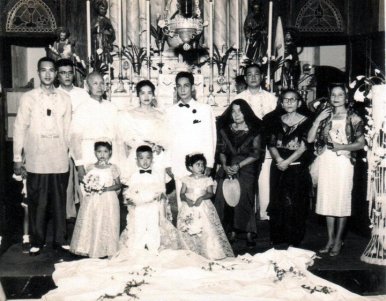
Notice that the guests where wearing black dresses and black ribbons for the men, this occasion was made a month after Lola Pacita (the bride’s mother) died. They thought of postponing it, but decided to push thru.
St Paul Cathedral
Built by the Augustinians in 1790-1800 in a distinctive earthquake baroque architecture. It has three naves, twelve altar and a choir loft. Chinese influence is evident in it’s baptistry altar, brass communion hand rail, a pair of Fu Dogs and mouldings on the façade. Most of the original church interior features are still in place.
The octagon belfry is located 10 meters south of the cathedral.

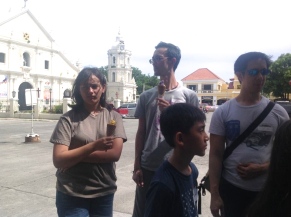
It was in this cathedral where Antonio Villanueva married Teresita Florendo in January 6, 1963.

The reception was held at the Vigan Ancestral House grounds.
St Paul College – Rosary College
Seven Paulinian sisters, headed by Sister Marthe de St. Paul, began the elementary, catechetical and musical instruction, as well as the teaching or arts and crafts to young girls. Intermediate instruction for young ladies began in 1912.
The school was first known as the Girl’s College of Our Lady of the Rosary, which then changed to the Rosary Academy.
The incorporation of tertiary education for women happened only in 1946, as it was delayed by World War II.
Rosary College became known as St. Paul College of Ilocos Sur (SPCIS) in 1971. A lot of the Villanueva grandchildren attended school here as well as the triplets.

Triplets at Rosary College
Casa Donato (Grand Pa’s Inn)

Grand Pa’s Inn

The house was a gift of the Donato sisters ( Filomena, Rufina and Rosario) to their half brother, Mariano upon his marriage to Carmen Rivero in 1923. It was the first house in Vigan that had a bidet and interal plumbing. The children from this marriage where Philomena, Milagros, Salvador, Salud, Angeles, Socorro, Serafin, Raoul and Maricar.

Mariano Donato’s Family
The family fortune was founded by an industrious Chinese “panadero” baker, Don Ah Toh, from where the present family surname DONATO was derived.
Villa Angela
This house is typical of those constructed in Vigan in the 1800s. Agapito B. Florendo, a gobernadorcillo, had it built in 1870.
The house itself is part of a 2,000 square meter property owned by the prominent Versoza family.

They named it after their matriarch, Angela(5th Gen) Villanueva (1878-1972) married to Pastor Versoza. She was the 4th of 8 children of Leonardo Villanueva and Juliana Florendo.
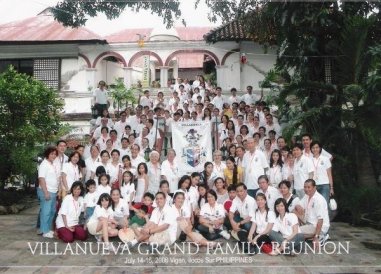
The property was restored by descendants in the eighties. It has since then become a depository of the mementos acquired by the family from the earliest years onwards, which they proudly share with their visitors.

Leona Florentino House
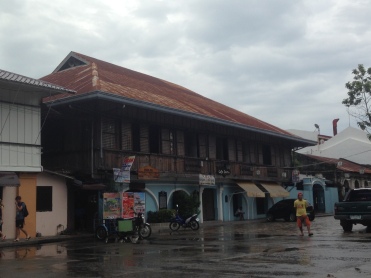
A statue of Leona Florentino in a small park across this 1797 house. It was placed there to give recognition to the first Filipina poet who achieved international attention.
The house is indeed worth a visit if only to get to know who Leona Florentino was. She was a remarkable woman who came from a very distinguished family of patriots and produced a generation of new ones. She was the mother of the first champion of the labor movement in the Philippines and the Philippine Independent Church, Isabelo delos Reyes.

Her full name is Leona Villanueva-Florentino. She is the daughter of Esteban Villanueva (3rdGen) 1797-1898 of the Basi Revolt Paintings. Leona Villanueva married Maeacio Florentino who died in 1867 and she remarried Elias delos Reyes the father of Vigan’s local hero, Isabelo.
Isabelo also inherited from his mother her literary talents, for he also made his mark in Philippine literature.

Leona Florentino monument
On July 7, 1864, Isabelo de los Reyes also known as Don Belong, co-founder of the Aglipayan Church, often dubbed as the “Father of Filipino Socialism”, was born in Vigan, Ilocos Sur . At the age six, the young Isabelo was committed by his father to the care of a rich relative, Don Mena Crisologo due to his parents’ troubled marriage.
He was elected senator of the first senatorial district which comprised the Ilocos provinces from 1922 to 1928.
Senate President Manuel L. Quezon more than once made him preside over the sessions of the Senate to the satisfaction and amusement of the members and the public because of his peculiar mannerisms.
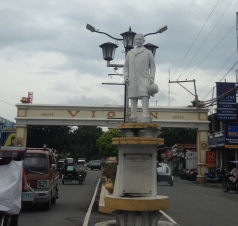
Isabelo delos Reyes
After his term as senator, he devoted his time to religion and writing. As an honorary bishop of the Aglipayan Church, he wrote many sermons and other religious tracts. He was the author of most of the Aglipayan literature such as the Biblia Filipina, the Aglipayan Calendar and the Divine Office.

Stricken with paralysis, Don Belong became bedridden until his death on October 10, 1938.
The Isabelo de los Reyes Elementary School in Tondo, Manila was named after his honor.
Calle Crisologo
You will be guided through four blocks of cobblestone streets lined with heritage houses of the families of the Filipino-Chinese traders who rose to prominence during that time of vigorous trading in abel cloth, indigo, gold, tobacco and other goods that were transported to Vigan from all over the North.
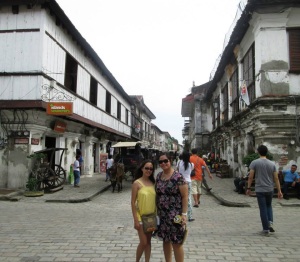
Calle Crisologo
The street is named after, Mena Pecson Crisologo is among the most-respected sons of the Ilokos region. He wrote Mining wenno Ayat ti Kararwa, which many compare to Jose Rizal’s Noli Me Tangere; an Ilocano translation of Don Quixote entitled Don Calixtofaro de la Kota Caballero de la Luna; and a zarzuela entitled Codigo Municipal.
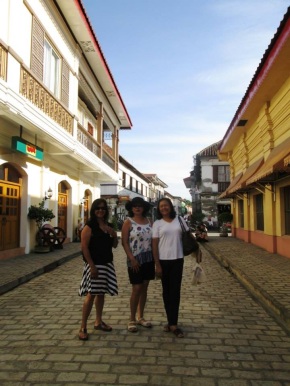
Calle Crisologo
A miracle actually saved the town of Vigan during the last days of the Japanese occupation. As part of their military strategy at the end of the war, the Japanese were ordered to burn and completely destroy occupied zones before withdrawal. On the eve of their departure from Vigan, the Japanese Military Commander, Captain Fujiro Takahashi pleaded with the SVD procurator of the Vigan Seminary, Fr. Joseph Kleikamp, to take custody of the Japanese officer’s Filipino wife and their love child. The priest agreed on the condition that Takahashi and his men would leave Vigan without burning the town to prevent the town folks from seeking revenge on his family. (At that time, drums of gasoline was already strategically stored at the town plaza, ready to be used in burning the town). Takahashi agreed and left with his troops during the night.
The following morning, the people of Vigan discovered that the Japanese had left peacefully. They immediately spread an oversized American flag at the plaza forestalling the planned bombing by the Americans to flush out the Japanese forces. Thus, Vigan miraculously escaped total destruction, a misfortune that befell other colonial cities like Cebu and Intramuros in Manila were burned. (reference: Vigan Files)
Burgos Museum
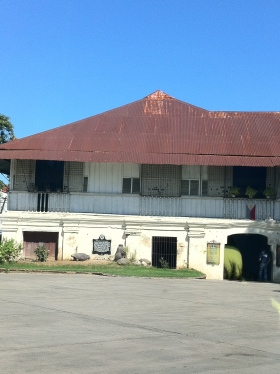

This is the ancestral house of Padre Jose Burgos. It is an excellent showcase of archeological and ethnographic treasures, antiques, dioramas of local and historical events and photographs of Ilocano heroes and achievers. A priceless collection of 14 Esteban Villanueva canvases depicting the 1807 Basi revolt.
Esteban Villanueva (3rd gen) is the son of Placido Villanueva (2nd Gen) and Justa Pichay. He was born on Sept 2, 1797 and died Jan 27,1898.
Esteban Villanueva (3rd Generation) 1797-1898 married Petrona Acosta 1798-1858, they had 7 children and one of then is Leona Villanueva 1828-1848 (Poetess) married Maeacio Florentino 1826-1867.

A photo of our grandfather, Fidel Villanueva is displayed in the Museum with other important personalities in the region.

Villanueva Ancestral Home

The house was built in the 1920’s as a gift of Lola Pacita’s parents, Ladislao and Januaria when she married Fidel Banez Villanueva. They knew her fondness for her hometown Vigan. It’s architecture is a cross between the Spanish Colonial period and early American period. The house was originally built in the Villanueva property in the Heritage Zone of Vigan. In 1975, his son Antonio, transferred the house to another property just in the border of Vigan and Bantay so his children can have a large garden to play
. 

The house was dismantled piece by piece, brick by brick and put together again like a puzzle where it stands today. Some of the children of Manoling Villanueva were born in this house. The children of Manoling and Delfin stayed in this house during school days. Antonio wanted to preserve this house, so his family can have a reminder of their childhood as well as his children and their children.
This tour had shown how rich and how colourful the Villanueva Heritage is. They always, say you must understand your past to able to move on to the future.
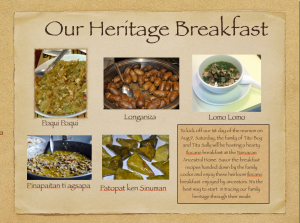































Recent Comments